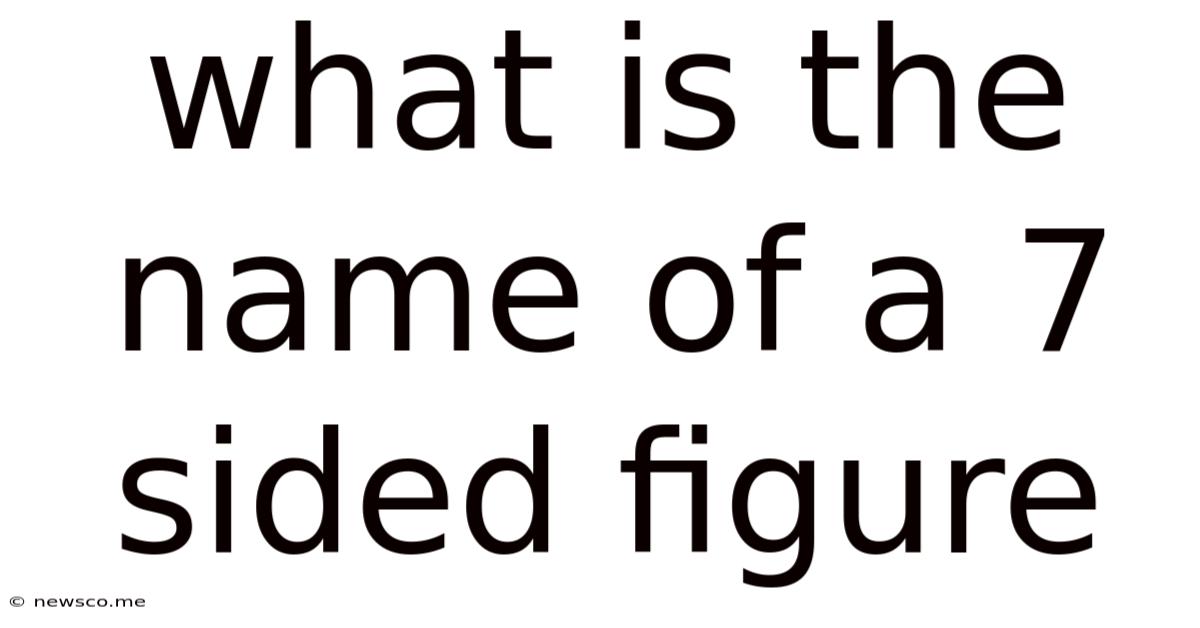What Is The Name Of A 7 Sided Figure
News Co
Apr 23, 2025 · 5 min read

Table of Contents
What's in a Name? Understanding Heptagons and Their Properties
The question, "What is the name of a 7-sided figure?" has a simple answer: a heptagon. However, the journey to understanding heptagons goes far beyond a single word. This comprehensive exploration delves into the fascinating world of heptagons, uncovering their properties, historical significance, and applications in various fields. We'll also explore related geometric concepts to provide a complete and enriching learning experience.
Defining the Heptagon: More Than Just Seven Sides
A heptagon, also known as a septagon, is a polygon with seven sides and seven angles. Polygons are closed, two-dimensional shapes formed by straight lines. The prefix "hepta" comes from the Greek word "hepta," meaning seven. This directly links the name to its defining characteristic: the number of sides.
Regular vs. Irregular Heptagons
Heptagons aren't all created equal. They fall into two main categories:
-
Regular Heptagon: A regular heptagon possesses seven congruent sides (sides of equal length) and seven congruent angles (angles of equal measure). Each interior angle of a regular heptagon measures 128.57 degrees. Constructing a perfect regular heptagon using only a compass and straightedge is impossible, unlike many other regular polygons. This fact adds to the mathematical intrigue surrounding this shape.
-
Irregular Heptagon: An irregular heptagon has sides and angles of varying lengths and measures. The variety of possible combinations of side and angle lengths makes irregular heptagons incredibly diverse in their appearance.
Exploring the Mathematical Properties of Heptagons
Understanding the mathematical properties of heptagons is crucial for their application in various fields, including architecture, design, and even computer graphics.
Interior Angles and Their Sum
The sum of the interior angles of any polygon can be calculated using the formula: (n - 2) * 180°, where 'n' represents the number of sides. For a heptagon (n = 7), the sum of interior angles is (7 - 2) * 180° = 900°.
Exterior Angles and Their Sum
The sum of the exterior angles of any polygon, regardless of the number of sides, always equals 360°. This property holds true for heptagons as well.
Area Calculation
Calculating the area of a regular heptagon is more complex than simpler polygons. Several methods exist, but they often involve trigonometry or advanced geometrical principles. One common approach utilizes the formula: Area = (7/4) * s² * cot(π/7), where 's' is the side length. For irregular heptagons, the area calculation becomes significantly more involved and often requires breaking down the shape into smaller, simpler polygons.
Diagonals
A heptagon has a total of 14 diagonals. A diagonal is a line segment that connects two non-adjacent vertices of a polygon. The number of diagonals in any polygon with 'n' sides can be calculated using the formula: n(n - 3) / 2.
Heptagons in the Real World: Applications and Examples
While not as commonly encountered as triangles, squares, or hexagons, heptagons find their place in various real-world applications:
Architecture and Design
Heptagons, particularly regular ones, can be found in some architectural designs, though they are less prevalent than other polygons. The unique shape can contribute to visually interesting and distinctive structures.
Nature
While less common than other polygons in natural formations, certain crystals and naturally occurring patterns might exhibit heptagonal symmetry. The rarity adds to their intrigue and emphasizes their mathematical elegance.
Engineering
Heptagonal shapes might be used in specialized engineering projects where a seven-sided structure is optimal for a specific purpose. The specific application depends on the unique demands of the engineering challenge.
Computer Graphics and Game Development
In computer graphics and game development, heptagons can be used to create unique shapes and textures. The irregular heptagon, with its versatile form, provides designers with greater creative freedom.
Tessellations
While a regular heptagon cannot tessellate (tile a plane without gaps or overlaps), irregular heptagons can be part of more complex tessellations. This property has implications in design and pattern creation.
Constructing a Heptagon: The Challenge of Precision
Constructing a perfect regular heptagon using only a compass and straightedge is famously impossible. This is because the angle subtended by each side cannot be constructed using standard geometric techniques. However, approximate constructions can be achieved through various methods, including using iterative algorithms or employing advanced geometric tools. This impossibility underscores the mathematical complexity inherent in the heptagon.
Beyond the Heptagon: Exploring Related Geometric Concepts
Understanding heptagons can lead to a broader appreciation of geometry and related concepts:
Polygons in General
Heptagons belong to the broader family of polygons, which encompass shapes with three or more sides. Studying heptagons provides insights into the properties and characteristics of polygons as a whole.
Other Regular Polygons
Comparing and contrasting heptagons with other regular polygons like triangles, squares, pentagons, hexagons, and octagons reveals fascinating patterns and mathematical relationships between the number of sides, angles, and areas.
Trigonometry and Geometry
The calculation of area and angles in heptagons relies heavily on trigonometric functions and geometric principles. This emphasizes the interconnection between these branches of mathematics.
Conclusion: The Enduring Appeal of the Heptagon
The heptagon, while not as ubiquitous as some other polygons, possesses a unique mathematical charm and real-world applications. Its seven sides and angles offer a fascinating challenge for mathematicians, designers, and engineers alike. Its relative rarity and the impossibility of its precise construction using basic tools only add to its intrigue. From its definition and properties to its applications and related geometric concepts, the heptagon offers a rich tapestry of mathematical exploration and real-world relevance. The next time you encounter a seven-sided figure, remember its name—the heptagon—and appreciate the mathematical elegance it represents.
Latest Posts
Related Post
Thank you for visiting our website which covers about What Is The Name Of A 7 Sided Figure . We hope the information provided has been useful to you. Feel free to contact us if you have any questions or need further assistance. See you next time and don't miss to bookmark.